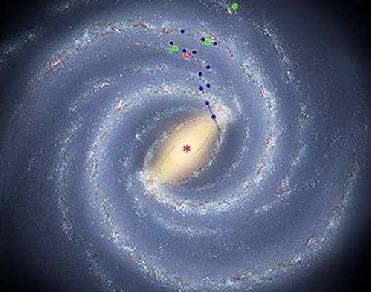
Artist's Conception of our Milky Way Galaxy: Blue, green dots indicate distance measurements. CREDIT: Robert Hurt, IPAC; Mark Reid, CfA, NRAO/AUI/NSF
NEW YORK (BNS): The speed with which our home galaxy Milky Way is rotating makes it one helluva reckless traveller! And more prone to accidents.
According to scientists at the Harvard-Smithsonian Center for Astrophysics, �We're faster, heavier, and more likely to collide than we thought. Astronomers making high-precision measurements of the Milky Way say our home Galaxy is rotating 100,000 miles per hour faster than previously understood.�
Scientists at the prestigious Massachusetts-based institute have found that Milky Way, of which our solar system is a part, is moving at 600,000 miles per hour in the galactic orbit, which is higher by 100,000 miles per hour than previously estimated.
That increase in speed, said Mark Reid of the Harvard-Smithsonian Center for Astrophysics, heightens the Milky Way's mass by 50 per cent, bringing it even with largest neighbour Andromeda galaxy. "No longer will we think of the Milky Way as the little sister of the Andromeda galaxy in our Local Group family." Reid said.
According to estimates the larger mass, in turn, means a greater gravitational pull that increases the likelihood of collisions with the Andromeda galaxy or smaller nearby galaxies.
Observations indicate that if our Solar System is about 28,000 light years from the Milky Way's center, then we are moving at about 600,000 miles per hour in our Galactic orbit, up from the previous estimate of 500,000 miles per hour.
The scientists used the National Science Foundation's Very Long Baseline Array (VLBA) radio telescope to remake the map of the Milky Way. The VLBA is a system of 10 radio-telescope antennas stretching from Hawaii to New England and the Caribbean. It can fix positions in the sky so accurately that the actual motion of the objects can be detected as they orbit the Milky Way's centre.
The results were recently reported at the American Astronomical Society's meeting in Long Beach, California.
"The new VLBA observations of the Milky Way are producing highly-accurate direct measurements of distances and motions," said Karl Menten of the Max Planck Institute for Radio Astronomy in Germany, a member of the team. "These measurements use the traditional surveyor's method of triangulation and do not depend on any assumptions based on other properties, such as brightness, unlike earlier studies."
Reid reported that "most star-forming regions do not follow a circular path as they orbit the Galaxy; instead we find them moving more slowly than other regions and on elliptical, not circular, orbits."
The researchers attribute this to what they call spiral density wave shocks, which can take gas in a circular orbit, compress it to form stars, and cause it to go into a new, elliptical orbit. This, they explained, helps to reinforce the spiral structure.
Reid and his colleagues found other surprises, too. Measuring the distances to multiple regions in a single spiral arm allowed them to calculate the angle of the arm. "These measurements," Reid said, "indicate that our Galaxy probably has four, not two, spiral arms of gas and dust that are forming stars." Recent surveys by NASA's Spitzer Space Telescope suggest that older stars reside mostly in two spiral arms, raising a question of why the older stars don't appear in all the arms. Answering that question, the astronomers say, will require more measurements and a deeper understanding of how the Galaxy works.
 Previous Article
Previous Article Next Article
Next Article













The Indian Air Force, in its flight trials evaluation report submitted before the Defence Ministry l..
view articleAn insight into the Medium Multi-Role Combat Aircraft competition...
view articleSky enthusiasts can now spot the International Space Station (ISS) commanded by Indian-American astr..
view article